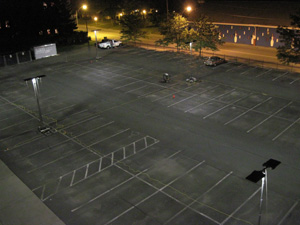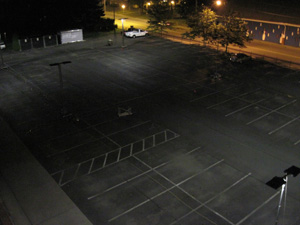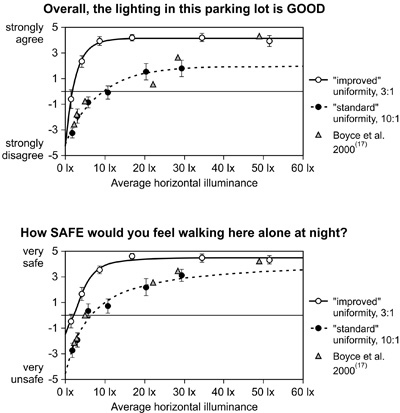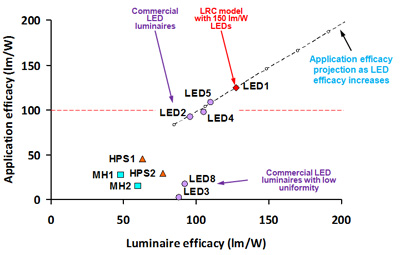Parking Lot Lighting with Improved Uniformity

Demonstration parking lot with improved uniformity illuminance (3:1 maximum to minimum illuminance).

Demonstration parking lot with standard uniformity illuminance (10:1 maximum to minimum illuminance). |
Outdoor lighting, including site, parking and street lighting, is a rapidly growing market for LED-based solutions. Municipalities, commercial property owners, and utilities are considering replacing existing high-intensity discharge (HID) lighting with LEDs. However, the main question they face is how to meaningfully compare LED-based solutions with traditional technologies, not only on the basis of light source efficacy but as a system and, more importantly, as an application.
To help with evaluations of parking lots and street lighting applications, in 2009 ASSIST developed a metric called luminaire system application efficacy (LSAE). This metric allows designers and specifiers to select luminaires that will provide the required light levels and uniformity levels on the task while using the least possible electricity. LRC research has shown that LSAE provides a good correlation to lighting power density and can be used to rank order individual luminaires, groups of luminaires, or a complete installation.
The LSAE metric was developed using the illuminance and uniformity criteria specified by
IESNA’s Recommended Practice for Lighting of Parking Facilities RP-20-98 (the recommendation available at that time), with the understanding that more energy could be saved if the absolute light levels and uniformity ratios required in a parking lot were better understood. Current recommended practice does not favor highly uniform designs; the latest version of RP-20 (2014) allows for a uniformity ratio as high as 15:1 (in 1998, the maximum ratio recommended was 20:1). However, improved uniformity is expected to result in better user acceptability ratings at reduced light levels, and thus has the potential to allow for reduced energy use from outdoor luminaires. In this study, the Lighting Research Center sought to better understand the benefits of high illuminance uniformity on outdoor area or parking lot lighting.
Project Objectives
The Lighting Research Center performed a demonstration to test the relationship between uniformity and occupant acceptance in parking lots. The objectives of the study included:
• Better understand the relationship between illuminance, uniformity and:
- Perception of safety and security
- Visibility
- Energy efficiency
• Calculate the advantage LED luminaires offer at producing more uniform beam patterns compared with HID luminaires
Demonstration Site and Conditions
An urban parking lot in Troy, N.Y., was selected for the demonstration and user evaluation. The site measured 150 ft. by 250 ft. and was bordered by illuminated streets on two sides. The parking lot was illuminated with two uniformity conditions—10:1 (“standard”) and 3:1 (“improved”) maximum-to-minimum ratios—and six nominal light levels (ranging 2 lx [0.2 fc] to 60 lx [6 fc]).
The installation consisted of six temporary poles, each with two LED luminaires mounted back-to-back at a height of 18 ft. Poles were spaced 70 ft. by 70 ft. The rated output of the LED luminaires was 17,500 lumens (initial), 4300 K, and 243 W. The intensity distribution was classified as Type V, square. Each luminaire was retrofitted with dimmable LED drivers; one dimmer controlled both luminaires on each pole. By turning off the central poles, uniformity was reduced to the standard 10:1 ratio.
Human Factors Evaluation Results
In November 2012, the LRC recruited 15 neighbors, visitors, and regular users of the parking lot to answer survey questions about the 12 different lighting conditions (2 uniformities x 6 light levels) after dark. All evaluations were conducted on clear nights with no full moon and minimal contribution from adjacent street lighting.
The graphs below show the responses to each of the twelve lighting conditions for two questions: Overall, the lighting in this parking lot is good and How safe would you feel to walk here alone at night? These two questions are representative of the results found for the rest of the survey.

Human factors evaluation results for two survey questions for each uniformity condition at each light level condition (Narendran et al., in press).
As shown, users perceived the lighting as more “safe” and “good” at lower light levels when presented with improved uniformity (3:1 ratio) compared with standard uniformity (10:1 ratio). Importantly, even when presented with the highest light levels, users gave lower ratings to the standard uniformity condition compared to the improved uniformity condition. Similar results were found for other lighting quality questions such as perceived brightness, ability to see tripping hazards, recognize people, and see around the parking lot perimeter. These results demonstrate that improved uniformity makes lighting parking lots to an average greater than about 10 lx unnecessary. In addition to limiting energy use, this would appeal to those concerned about light pollution. These results are highly consistent with independent evaluations conducted in typical parking lots by Boyce et al. (Perceptions of safety at night in different lighting conditions, Lighting Research & Technology 2000).
LSAE Analysis and System Comparisons
The results from the human factors evaluation of parking lot uniformity show that it is possible to save energy (up to 75% in this demonstration) by providing better uniformity at a lower average light level. Because LEDs are small and distributed light sources, they are more effective at creating uniform distributions than larger and single light sources such as high pressure sodium (HPS) or metal halide (MH), which will result in a higher application efficacy and thus lower energy use.
Using modeling software, the LRC conducted an optical ray-tracing analysis to understand how much uniformity is achievable with LED fixtures. A custom, optimized LED parking lot fixture was designed assuming an LED efficacy of 150 lm/W, 95% optical efficiency, and 90% driver efficiency. The result was a fixture with 90 W total luminaire power, 127 lm/W luminaire efficacy, and a 2.5:1 illuminance uniformity. The custom LED fixture was then analyzed for its LSAE value and compared to the LSAE values calculated for 9 commercially available, IES-type VS (short) luminaires that would produce an average illuminance of ~10 lx (5 LED, 2 HPS, 2 MH) for a computer-simulated parking lot with 9 poles. (See "Benefits of improved illuminance uniformity for parking lot lighting" presentation for calculation procedure and further details.)
The custom LED luminaire had an LSAE value of 125 lm/W, compared with one HPS luminaire at 45 lm/W LSAE, and one MH luminaire at 27 lm/W LSAE. The graph below shows all 10 luminaires plotted with their LSAE value as a function of their traditional luminaire efficacy value.

LSAE application efficacy as a function of traditional luminaire efficacy for each of the parking lot luminaires compared (Narendran et al., in press).
Conclusions
In parking lots, for equal average illuminance, uniform lighting provides: 1) higher ratings of visibility and brightness perception, as well as higher ratings of perceived safety and security, and 2) lower energy use because uniform lighting allows equal or higher occupant ratings at much lower light levels – this is expected to translate to energy savings of up to 75%.
LEDs have an optical advantage over larger size sources in creating uniform beam distributions and can be dimmed to achieve lower target light levels without reducing uniformity. With present-day LED luminaires, an application efficacy of 100 lm/W is possible by tailoring the beam to provide an average of 10 lx with a (max/min) 3:1 or better uniformity. This provides an LSAE value twice that of HPS.
Technical Reports & Presentations
 Summary Poster: Parking Lot Lighting with Improved Uniformity (2015) Summary Poster: Parking Lot Lighting with Improved Uniformity (2015)
Field Test DELTA Snapshots: Benefits of Improved Uniformity with LED Parking Lot Lighting (2015)
Narendran, N., J.P. Freyssinier, and Y. Zhu. 2016. Energy and user acceptability benefits from improved illuminance uniformity of parking lot illumination. Lighting Research and Technology, 48(7): 789–809; published online ahead of print 4 June 2015, doi:10.1177/1477153515587959.
"Using uniformity to optimize parking lot lighting" ALAN 2015: 3rd International Conference on Artificial Light at Night, Sherbrooke, Quebec, Canada, May 29-31, 2015.
"Benefits of improved illuminance uniformity for parking lot lighting" IES Roadway Lighting Committee Spring Meeting, Houston TX, March 27, 2015. 
"Benefits of improved illuminance uniformity for parking lot lighting" IES Street and Area Lighting Conference 2014, Nashville TN, September 16, 2014.
Media Coverage
LRC study shows uniform lighting in parking lots provides better sense of security, 75% energy savings – Press Release (2015)
Related Research Websites
ASSIST recommends: Parking Lot Lighting
ASSIST recommends: Outdoor Lighting
Tools to Evaluate Outdoor Lighting
Parking Lot Luminaire Online Calculator
Sponsors
New York State Energy Research and Development Authority (NYSERDA)
Alliance for Solid-State Illumination Systems and Technologies (ASSIST)
Luminaire Donation: GE Lighting Solutions
|


